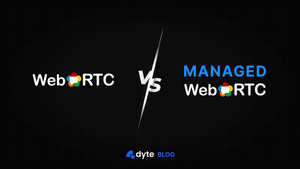If you've ever been curious about how video calls, live streams, or online gaming work behind the scenes, you've likely heard of WebRTC.
But what's the difference between standard WebRTC and Managed WebRTC?
Let's unravel the complexities of WebRTC vs Managed WebRTC, comparing their features, benefits, and potential drawbacks. Whether you're a seasoned developer or just someone interested in the mechanics of online communication, we aim to shed light on these critical components of the digital landscape.
Stay tuned as we explore the intricacies of WebRTC and Managed WebRTC, helping you understand which might be the best fit for your next project or product. Buckle up for an enlightening journey through the realm of real-time communications!
What is WebRTC?
WebRTC, short for Web Real-Time Communication, is an open-source project that provides web browsers and mobile apps with real-time communication (RTC) using simple application programming interfaces (APIs). It allows audio/video communication to work inside web pages by enabling direct peer-to-peer communication and eliminating the need to install plugins or download native apps.
Supported by Google, Microsoft, Mozilla, and Apple, WebRTC is used in various applications that require real-time communication, such as web conferencing, file transfer, chat, desktop sharing, and gaming. The main components of WebRTC include:
- GetUserMedia: This allows a web browser to access the camera and microphone.
- PeerConnection: This enables the setting up of audio/video calls.
- DataChannels: These allow browsers to share data via peer-to-peer.
Yes, WebRTC is the backbone of video communication; however, WebRTC has limitations of its own, such as limited customizations, complex configurations, limited browser support, and other quality and scalability challenges. And that's where Managed WebRTCs come in as an effective WebRTC alternative.
What is a Managed WebRTC?
Managed WebRTC refers to a service that offers Web Real-Time Communication (WebRTC) capabilities as part of a managed service. This means that instead of building, maintaining, and scaling your own WebRTC infrastructure, you can leverage the expertise and resources of a company specializing in these services.
A Managed WebRTC service typically provides:
- Scalability: Managed WebRTC services are designed to handle large-scale RTC applications, automatically adjusting to accommodate varying demands.
- Reliability: These services often come with built-in redundancy and failover mechanisms to ensure that your application remains available and functional.
- Security: Managed WebRTC services often provide enhanced security measures such as encryption and secure real-time transport protocol (SRTP) to protect data and communication.
- Quality of Service: They offer quality assurance with features like adaptive bitrate streaming and network jitter management to ensure smooth audio and video communication.
- Support and Maintenance: Managed services take care of updates, bug fixes, and technical issues, freeing up your team to focus on core product development.
Basically, a Managed WebRTC service provides all the benefits of WebRTC without requiring you to deal with the complexities of setting up, running, and maintaining a WebRTC infrastructure. This can be particularly beneficial for businesses that want to quickly implement real-time communication features but lack the necessary in-house expertise or resources.
WebRTC vs Managed WebRTC: Detailed comparison
| Feature | WebRTC | Managed WebRTC |
| Cost | Free to use. | Typically comes at a cost, depending on the service provider. |
| Setup & Maintenance | Requires significant technical expertise for setup and maintenance. | The service provider handles setup and maintenance, reducing the technical effort required. |
| Network Management | Handling network complexities like NAT traversal and firewall permissions can be challenging. | These complexities are managed by the service provider. |
| Scalability | Scaling can be complex and requires additional infrastructure and management. | Service providers often handle scalability, making it easier to accommodate more users. |
| Support | As an open-source project, support is community-based and may not be as reliable. | Often includes dedicated customer support, providing more reliable assistance. |
| Additional Features | Basic real-time communication features. Advanced features require additional development. | Often includes additional features like analytics and easy-to-use APIs. |
| Control Over Infrastructure | More control over the infrastructure since you're managing it yourself. | Less control over the infrastructure as it's managed by the service provider. |
List of Managed WebRTC platforms
With Managed WebRTCs, you can leverage the strengths of WebRTC and the power of customizations and scalability that are native to various managed WebRTC platforms.
Dyte
With separate UI components and granular control over user permissions, you can tailor your live video solution to your unique use cases, empowering you to create applications with personalized design and functionality. Dyte's Video SDK offers customization options throughout, along with superior call quality. Backed by its robust build on multiple cloud providers, it lets you scale scalability reliably.
Check out how Dyte compares with WebRTC in terms of features, customizations, scalability, and effort.
Zoom SDK
The Zoom Video SDK lets developers leverage Zoom's high-quality video, audio, and interactive features within their own applications. Developers can create custom user interfaces and experiences without any Zoom branding.
However, Zoom SDK’s pricing details aren't the most transparent and if you are looking for Zoom Video SDK alternatives, check out the feature-wise comparison of Zoom vs Dyte.
We have a curated list of great Zoom alternatives if you are looking for an alternative to Zoom's video conferencing.
Vonage
Vonage's Video API offers real-time communication that can be easily integrated into web and mobile applications. It also provides features like screen sharing, recording, and analytics.
Although Vonage is a good tool, it has certain limitations, such as a heavy SDK footprint, lack of plugins, polls, AI/ML middleware, and more. You can compare Vonage with Dyte Video SDK features.
Twilio Video
Twilio's Programmable Video API is also a well-known platform that allows developers to embed real-time video within their applications.
However, there are some restrictions when it comes to platforms being supported, such as the number of participants allowed per call, no UI support, etc. If you are looking for Twilio alternatives, here's a feature-by-feature comparison of Twilio vs Dyte.
Agora
Agora's real-time engagement platform offers voice, video, and messaging capabilities. Despite its robust features, it may fall short in terms of scalability and customization options. You can consider Dyte's Video SDK as an Agora alternative. Check out a detailed comparison of Agora vs Dyte.
Conclusion
The decision between WebRTC and Managed WebRTC hinges on your project's specific requirements, your team's technical expertise, and the resources at your disposal. If you have the technical know-how and time to manage the setup and maintenance, WebRTC offers a powerful and cost-effective solution for enabling real-time communication.
However, if you are looking for faster integration and development costs, Managed WebRTC is the way to go. Dyte accelerates your journey of live video integration, offering enterprise-class scalability, HD call quality, and extensive customization in a single, efficient video conferencing SDK.
Start building with 10K free credits, here are a few resources to help you evaluate Dyte
Interested? Let’s talk.
FAQs
Is WebRTC free to use?
Yes, WebRTC is an open-source project and is free to use.
Does Managed WebRTC come at a cost?
Yes, Managed WebRTC usually comes at a cost, depending on the service provider.
Which one requires more technical expertise: WebRTC or Managed WebRTC?
WebRTC requires more technical expertise as you'll need to handle the setup and maintenance yourself. Managed WebRTC, on the other hand, is handled by the service provider, requiring less technical effort from your side.
Which one is more scalable: WebRTC or Managed WebRTC?
Managed WebRTC services typically handle scalability, making it easier to accommodate more users. With WebRTC, scaling can be complex and requires additional infrastructure and management.



